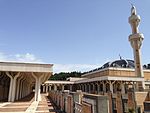Aniene
Geography of RomeItaly river stubsLazio geography stubsRivers of ItalyRivers of the Province of Frosinone ... and 2 more
Rivers of the Province of RomeTributaries of the Tiber

The Aniene (pronounced [aˈnjɛːne]; Latin: Aniō), formerly known as the Teverone, is a 99-kilometer (62 mi) river in Lazio, Italy. It originates in the Apennines at Trevi nel Lazio and flows westward past Subiaco, Vicovaro, and Tivoli to join the Tiber in northern Rome. It formed the principal valley east of ancient Rome and became an important water source as the city's population expanded. The falls at Tivoli were noted for their beauty. Historic bridges across the river include the Ponte Nomentano, Ponte Mammolo, Ponte Salario, and Ponte di San Francesco, all of which were originally fortified with towers.
Excerpt from the Wikipedia article Aniene (License: CC BY-SA 3.0, Authors, Images).Aniene
Via della Foce dell'Aniene, Rome Parioli
Geographical coordinates (GPS) Address Nearby Places Show on map
Geographical coordinates (GPS)
| Latitude | Longitude |
|---|---|
| N 41.941745 ° | E 12.50181 ° |
Address
Via della Foce dell'Aniene
Via della Foce dell'Aniene
00199 Rome, Parioli
Lazio, Italy
Open on Google Maps







